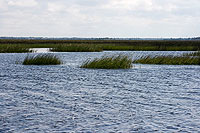The primary ecosystem that you will see when you paddle the Intracoastal Waterway in northeast Florida is salt marsh, one of the most productive ecosystems on the planet. The smooth cordgrass (Spartina alterniflora) and black needle rush (Juncus roemerianus) host a plethora of wading birds and insects above the waterline, but provide homes for a lot more below the waterline.
 Salt marsh may seem like an inhospitable environment. The grasses are hardy and do not host many direct grazers. The plants and animals here have to tolerate being completely inundated or dry, depending on the tide. Temperature and salinity fluctuations are the norm. Yet, here life flourishes and salt marsh provides vital nurseries for larval fish.
Salt marsh may seem like an inhospitable environment. The grasses are hardy and do not host many direct grazers. The plants and animals here have to tolerate being completely inundated or dry, depending on the tide. Temperature and salinity fluctuations are the norm. Yet, here life flourishes and salt marsh provides vital nurseries for larval fish.
The tides and freshwater streams bring organic matter that combines with dead marsh grasses to provide food for the bacteria, crabs and fish that find a home in the salt marsh. Algae and seaweeds clinging to the grasses also join the food web. Tiny fish and mollusks eat the algae and in turn become food for herons, egrets and larger fish. The larger fish become food for cormorants, ospreys, bottlenose dolphins and still larger fish. Many of the fish that survive move out into the ocean as they grow, becoming a part of the fishery that is so vital to the area’s economy.
Animals that might be seen in the salt marsh include:
Blue crab, Bobcat, Bottlenose dolphin, Cattle egret, Clapper rail, Cormorant, Fiddler crab, Florida manatee, Great blue heron, Great egret, Green-backed heron, Killifish, Kingfish, Marsh rabbit, Marsh snails, Mullet, Needlefish, Osprey, Oyster, Raccoon, Red drum, Rice rat, Snook, Snowy egret, Tricolor heron, White shrimp
As you move to higher ground the salt marsh gives way to maritime hammock and pine flatwoods. Maritime hammocks are some of the most threatened habitat in the United States because of humans’ desire to live near water. These habitats support a variety of different species, including many that are threatened and endangered. Many species of migratory birds and butterflies use the area as part of the Eastern Flyway.
Maritime hammock includes several species of oak cedars, palms and palmettos. Critters include songbirds, raccoons and armadillos. Pine flatwoods are also found near the salt marshes at several of the parks in this area. They are primarily made up of slash pine with a thick understory of bushes and wildflowers



